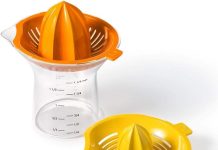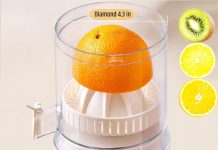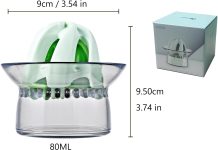Thinking of starting a juicing regimen but not sure where to begin? Look no further! In this article, we will guide you through the basics of juicing and provide you with some valuable tips to kickstart your juicing journey. From selecting the right juicer to choosing the perfect fruits and vegetables, we’ve got you covered. Get ready to nourish your body with a refreshing burst of fruity goodness!
Review contents
Choosing the Right Juicer
Consider Your Budget and Frequency of Use
When it comes to choosing the right juicer, it’s important to take into account your budget and how often you plan on using the juicer. Juicers come in a wide range of prices, so it’s crucial to determine how much you’re willing to spend. If you’re planning on juicing every day, investing in a higher quality juicer might be a wise decision. On the other hand, if you’re just starting out or juicing occasionally, a more affordable option might suit your needs better.
Evaluate Different Juicer Types
There are various types of juicers available on the market, each with its own advantages and disadvantages. The most common types are centrifugal juicers, masticating (or slow) juicers, and triturating (or twin-gear) juicers. Centrifugal juicers are fast but may not extract as much juice and nutrients as slow juicers. Masticating juicers operate at a slower speed and tend to produce a higher yield of juice. Triturating juicers are the most efficient but also the most expensive. Consider the pros and cons of each juicer type to find the one that aligns with your preferences.
Compare Features and Specifications
When selecting a juicer, it’s important to compare the features and specifications of different models. Look for features such as adjustable speed settings, large feeding chutes, pulp ejection systems, and noise levels. Consider the size and weight of the juicer if you have limited counter space. Additionally, check if the juicer is easy to assemble, disassemble, and clean. Comparing these features will help you find a juicer that suits your needs and makes the juicing process more convenient.
Selecting the Right Ingredients
Choose Fresh and High-Quality Produce
The quality of your ingredients plays a significant role in the taste and nutritional value of your juice. When selecting produce, opt for fresh fruits and vegetables that are ripe and in their prime. Avoid buying bruised or damaged produce, as they may affect the flavor and quality of the juice. If possible, choose organic produce to minimize exposure to pesticides and chemicals. By using high-quality ingredients, you can ensure that your juice is packed with nutrients and flavor.
Diversify Your Ingredients for Nutritional Variety
To maximize the nutritional benefits of your juice, it’s important to diversify your ingredients. Incorporate a variety of fruits and vegetables into your recipes to ensure you’re getting a wide range of vitamins, minerals, and antioxidants. Try experimenting with different combinations of ingredients to discover new flavors and health benefits. Don’t be afraid to mix fruits and vegetables together to create a balanced and nutritious juice.
Avoid Using Overripe or Damaged Fruits and Vegetables
While it’s important to choose fresh produce for juicing, it’s equally important to avoid using overripe or damaged fruits and vegetables. Overripe produce can affect the taste and texture of the juice, and may even introduce bacteria or mold. Inspect your ingredients carefully before juicing and discard any that are wilted, moldy, or rotten. By using fresh and undamaged produce, you’ll ensure that your juice is tasty and safe to consume.
Preparation and Safety Measures
Wash Your Produce Thoroughly
Before juicing, it’s crucial to wash your produce thoroughly to remove any dirt, pesticides, or bacteria that may be present. Use a vegetable brush to scrub firm-skinned fruits and vegetables under running water. For leafy greens, soak them in a bowl of water and gently agitate to remove any debris. Properly washing your produce will help eliminate any potential contaminants and ensure that your juice is clean and safe to drink.
Peel and Remove Seeds if Necessary
Depending on the type of juicer you’re using and your personal preference, you may need to peel certain fruits and vegetables before juicing. Some fruits, such as citrus fruits, bananas, and pineapples, should be peeled before juicing. Additionally, certain fruits and vegetables, like apples or grapes, may have seeds or pits that should be removed before juicing. Take the time to prepare your ingredients properly to avoid any unwanted flavors or textures in your juice.
Store Fruits and Vegetables Properly
To maintain the freshness and quality of your produce, it’s important to store them properly. Most fruits and vegetables should be stored in the refrigerator, as cooler temperatures help slow down the ripening process and preserve their nutrients. However, some fruits, like bananas and citrus fruits, are best kept at room temperature. Be sure to store your produce away from strong odors, as they can transfer and affect the flavor of other ingredients. By storing your fruits and vegetables correctly, you’ll be able to preserve their freshness and ensure their suitability for juicing.
Basic Juicing Techniques
Begin with Simple Recipes
If you’re new to juicing, it’s best to start with simple recipes that have familiar flavors. This will help you get accustomed to the taste and texture of freshly made juice. Simple recipes like apple-carrot or spinach-pineapple are a great way to ease into juicing. As you become more comfortable and adventurous, you can gradually incorporate more complex and unique recipes into your juicing routine.
Understand the Best Order to Juice Ingredients
When juicing multiple ingredients, it’s essential to understand the correct order in which to juice them. Generally, it’s recommended to juice leafy greens first, followed by firmer ingredients like fruits and vegetables. By starting with leafy greens, you ensure that the juicer extracts a maximum amount of juice from them. Firmer ingredients can help push the leafy greens through the juicer. Following the proper order will help optimize juicing efficiency and minimize clogging.
Experiment with Different Combinations
One of the best parts of juicing is the ability to experiment with different ingredient combinations. Don’t be afraid to get creative and try new flavors. Mix and match different fruits, vegetables, and herbs to create unique and delicious juices. Keep in mind that certain ingredients may overpower others in terms of taste, so it’s important to find a balance that suits your preferences. Through experimentation, you’ll discover your favorite flavor profiles and create personalized juice recipes.
Juicing Tips and Tricks
Add Leafy Greens for Extra Nutrients
Leafy greens are an excellent addition to any juice, as they provide a wide array of vitamins, minerals, and antioxidants. Spinach, kale, and Swiss chard are popular choices for juicing leafy greens. They add a boost of nutrients without overpowering the flavor of the juice. Start with a small handful and gradually increase the amount as you become accustomed to the taste. Leafy greens are particularly beneficial for those looking to increase their intake of essential nutrients.
Use Citrus Fruits for Enhanced Flavor
Citrus fruits, such as oranges, grapefruits, and lemons, are perfect for adding a burst of refreshing flavor to your juice. Citrus fruits not only enhance the taste but also provide a good dose of vitamin C and other beneficial compounds. Experiment with different citrus fruits to find your preferred flavor profile. You can juice them alone or combine them with other fruits and vegetables for a zesty and invigorating juice.
Mix in Superfoods for Added Health Benefits
Superfoods, like ginger, turmeric, and wheatgrass, can elevate the nutritional value of your juice. These ingredients are known for their potent health benefits and can be easily incorporated into your recipes. Adding a small amount of ginger root or a teaspoon of turmeric powder can provide anti-inflammatory properties. Wheatgrass is rich in chlorophyll and antioxidants. Be mindful of the intensity of superfoods, as too much can overpower the flavor of your juice.
Maintaining Your Juicer
Clean Your Juicer After Each Use
Keeping your juicer clean is essential for optimal performance and longevity. After each use, disassemble the juicer and rinse each part under warm running water. Use a brush or sponge to gently remove any pulp or residue. Pay close attention to the mesh filter, as this is where pulp can accumulate. Allow the juicer parts to air dry completely before reassembling. By practicing regular cleaning, you’ll prevent the buildup of bacteria and maintain the efficiency of your juicer.
Deep Clean Your Juicer Regularly
In addition to cleaning your juicer after each use, it’s important to perform a deep clean on a regular basis. This involves disassembling the juicer and thoroughly scrubbing each part with warm soapy water. Pay attention to hard-to-reach areas and ensure all residue is removed. Vinegar or lemon juice can also be used to remove stubborn stains or odors. Refer to your juicer’s instruction manual for specific cleaning guidelines. Regular deep cleaning will help prolong the lifespan of your juicer and keep it functioning optimally.
Check and Replace Parts if Necessary
Over time, certain parts of your juicer may experience wear and tear. It’s important to periodically inspect the parts for any signs of damage or deterioration. Check the blades, filters, and seals to ensure they are in good condition. If you notice any cracks, chips, or loose fittings, it may be time to replace those parts. Using a juicer with damaged components can affect its performance and potentially compromise the quality of your juice. Stay vigilant and replace any worn-out parts to keep your juicer running smoothly.
Storing and Consuming Fresh Juice
Store Juice Properly to Maintain Freshness
To maintain the freshness and quality of your juice, it’s crucial to store it properly. Freshly made juice is best consumed immediately after juicing to maximize its nutritional value. However, if you need to store it for later, transfer the juice into an airtight glass container and refrigerate it as soon as possible. Exposure to air and light can cause oxidation, which leads to nutrient degradation. Storing juice in a dark and cool environment will help preserve its freshness for a longer period.
Consume Fresh Juice Within 24-48 Hours
While storing juice is convenient, it’s important to note that its nutritional value begins to decline over time. It’s recommended to consume freshly made juice within 24-48 hours for optimal benefits. As time passes, the juice may lose some of its vitamins and enzymes. Regularly check the appearance and smell of stored juice before consuming it. If it appears or smells off, it’s best to discard it to ensure your safety.
Freeze Extra Juice in Ice Cube Trays
If you find yourself with excess juice that you can’t consume within the recommended timeframe, freezing it in ice cube trays can be a practical solution. Pour the juice into the trays, leaving some room for expansion. Once frozen, transfer the juice cubes into a freezer-safe bag or container. This way, you can easily retrieve individual portions of juice to thaw and enjoy later. Freezing juice in ice cube form helps preserve its freshness and nutritional content.
Potential Juicing Challenges
Dealing with Pulp and Fiber
One common challenge of juicing is determining what to do with the leftover pulp and fiber. Some juicers automatically separate the pulp from the juice, while others produce a pulpy juice. If you prefer a pulp-free juice, a centrifugal juicer is a good option. You can repurpose the pulp by incorporating it into baked goods, soups, or composting it for the garden. Alternatively, you can strain the juice to remove excess pulp, depending on your personal preference.
Managing Oxidation and Nutrient Loss
Oxidation is a natural process that occurs when juice comes into contact with air. It can cause a loss of nutrients and a change in flavor and color. To minimize oxidation, it’s advisable to drink your juice immediately after juicing or store it in airtight containers in the refrigerator. Adding a splash of lemon juice to your juice can also help slow down oxidation. Being mindful of the amount of time between juicing and consumption will help you maximize the nutritional benefits of your juice.
Overcoming Taste Preferences
Juicing allows for endless flavor combinations, but not everyone enjoys the taste of certain fruits or vegetables. If you have specific taste preferences or aversions, it may take some trial and error to find recipes that suit your palate. Start by incorporating small amounts of ingredients you’re unsure about and gradually increase the quantity as you become accustomed to the flavors. Don’t be discouraged if you don’t enjoy a particular juice; there are countless recipes to explore until you find the ones you love.
Health Benefits of Juicing
Increase Fruit and Vegetable Intake
One of the primary benefits of juicing is the ability to increase your intake of fruits and vegetables. Many people struggle to consume the recommended daily servings of produce, but juicing provides a convenient and efficient way to meet these requirements. Drinking juice allows your body to easily absorb the nutrients present in fruits and vegetables, providing you with a concentrated dose of vitamins, minerals, and antioxidants. By incorporating juicing into your daily routine, you can ensure you’re getting the essential nutrients your body needs.
Boost Nutrient Absorption
Juicing helps to break down the cell walls of fruits and vegetables, making their nutrients more easily absorbed by the body. The juicing process removes much of the fiber present in whole fruits and vegetables, allowing your digestive system to quickly access the vitamins and minerals they contain. This enhanced absorption of nutrients can support optimal health and wellbeing.
Support Overall Health and Well-being
Regularly consuming fresh juice can contribute to overall health and well-being. The vitamins, minerals, and antioxidants present in fruits and vegetables can boost the immune system, improve digestion, and help maintain healthy skin. Juicing can also promote hydration, which is crucial for various bodily functions. Additionally, incorporating a wide variety of fruits and vegetables into your juice can provide a diverse range of nutrients to support overall health.
Considerations for Beginners
Start Slowly and Gradually Increase Intake
If you’re new to juicing, it’s important to start slowly and gradually increase your juice intake. Your body may need time to adjust to the influx of nutrients and the change in dietary habits. Begin by replacing one meal or snack with a juice and monitor how you feel. Pay attention to any digestive changes or reactions your body may have. As you become more comfortable, you can gradually incorporate more juices into your daily routine.
Seek Professional Guidance if Needed
If you have specific health concerns or dietary restrictions, it’s advisable to seek professional guidance before starting a juicing regimen. Consulting with a healthcare provider, nutritionist, or dietitian can help ensure that juicing is safe and appropriate for your individual needs. They can provide personalized recommendations and guidelines to help you optimize your juicing experience.
Listen to Your Body’s Response
Everyone’s body is unique, and what works for one person may not work for another. It’s essential to listen to your body’s response when incorporating juicing into your diet. Pay attention to how you feel after consuming juice and make adjustments as needed. If certain ingredients cause discomfort or digestive issues, consider eliminating or modifying them in your recipes. By being in tune with your body, you can customize your juicing experience to suit your individual needs and preferences.



































